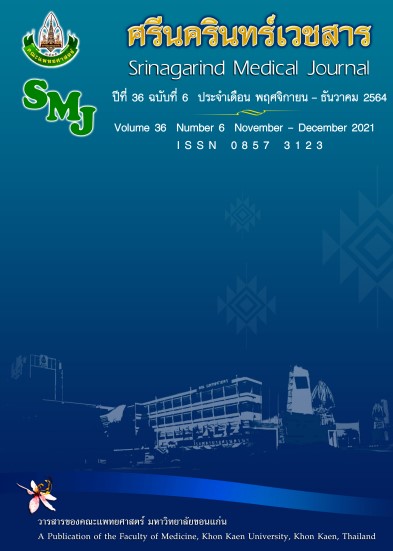The Effect of Elastic Band Exercises on Balance and Walking in Elderly Women with Kyphosis
Keywords:
Keywords: Elastic band exercise; kyphosis; balance; walkingAbstract
หลักการและวัตถุประสงค์: ภาวะกระดูกสันหลังค่อมส่งผลต่อความสามารถในการทรงตัว และการเดิน วัตถุประสงค์การศึกษาเพื่อเปรียบเทียบผลของการออกกำลังกายด้วยยางวงยืดต่อการทรงตัวและการเดินระหว่างกลุ่มออกกำลังกายด้วยยางวงยืดและกลุ่มควบคุม
วิธีการศึกษา: ผู้สูงอายุเพศหญิงที่มีภาวะกระดูกสันหลังค่อม อายุ 60-75 ปี จำนวน 40 ราย ถูกแบ่งเป็นกลุ่มทดลองและกลุ่มควบคุม (กลุ่มละ 20 ราย) กลุ่มทดลองได้รับการฝึกออกกำลังกายด้วยยางวงยืด 3 วันต่อสัปดาห์ วันละ 45 นาที เป็นเวลา 8 สัปดาห์ กลุ่มควบคุมได้รับการอบรมให้ความรู้เกี่ยวกับภาวะกระดูกสันหลังค่อม ก่อนและหลังการศึกษาอาสาสมัครทุกคนได้รับการประเมินการทรงตัวด้วย Timed Up and Go Test (TUGT) และ Functional reach test (FRT) ประเมินการเดินด้วย 10 meter walk test (10 MWT) วิเคราะห์ผลการศึกษาด้วยสถิติ t-tests
ผลการศึกษา: ความสามารถในการทรงตัว และการเดินที่ประเมินโดยใช้ TUGT, FRT และ 10 MWT ของกลุ่มออกกำลังกายด้วยยางวงยืด เพิ่มขึ้นมากกว่ากลุ่มควบคุมอย่างมีนัยสำคัญทางสถิติ (p < .001)
สรุป: การออกกำลังกายด้วยยางวงยืดสามารถเพิ่มการทรงตัว และการเดินได้ดีกว่ากลุ่มควบคุม จึงอาจเป็นทางเลือกหนึ่งสำหรับการพัฒนาการทรงตัว และการเดินของผู้สูงอายุที่มีภาวะกระดูกสันหลังค่อม
คำสำคัญ: การออกกำลังกายด้วยยางยืด; ภาวะกระดูกสันหลังค่อม; การทรงตัว; การเดิน
Background and Objectives: Kyphosis affects balance and walking ability. The purpose of this study was to compare effects of elastic band exercises on balance and walking performance in elderly women with kyphosis.
Methods: Forty elderly women with kyphosis, aged 60 -75 years, were divided into experimental and control groups (20 per group). The experimental group was assigned to practice elastic band exercises for 3 days/week, 45 minutes/day for a total of 8 weeks, while the control group only received knowledge related to kyphosis. At pre- and post study, all participants were tested for balance performance with the Timed Up and Go Test (TUGT) and Functional Reach Test (FRT). Walking performance was tested using a 10-meter walk test (10 MWT). T-tests were used to compare differences between the groups after the 8 week project.
Results: The elastic band exercise group had significantly better balance and walking performance than the control group after the 8 week period (p < .001).
Conclusion: Balance and walking performance of the elastic band exercise group were significantly improved over the control group at the conclusion of the program. This exercise is possibly an alternative exercise regimen for improving balance and walking performances in kyphosis elderly.




